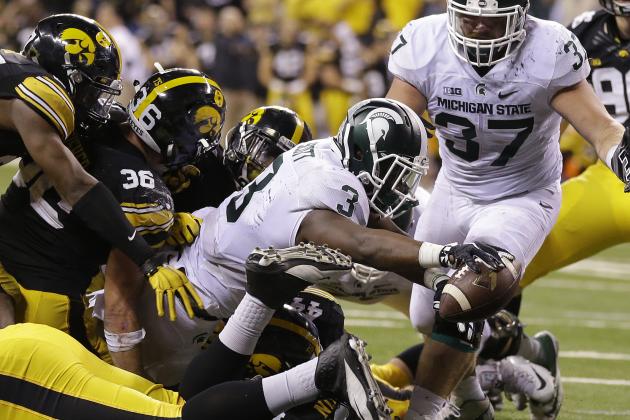This weekend, two conferences concluded their regular seasons while the other eight played their conference championship games. The former all had their automatic bids claimed; the latter needed to make it official. Now that they are, it's time to go to the Playoff Laboratory one final time... only this time, I'm doing this for real.
Those ten aforementioned conference champions all received an automatic berth to the 16 team field, while the remaining six spots were awarded at large to deserving teams who couldn't claim their conference crown. So how were those six decided, and how did I work out where everyone should be seeded? That latter question is just as important as the former; higher seeds get home field advantage for the first three rounds.
As for the selection criteria, I am a one-man selection committee who builds a bracket with the help of some metrics. I will use my own Non-Conference Schedule Strength and Playoff Points metrics to get started, and then I follow up with a pair of computer rankings that incorporate margin of victory (because that matters). These rankings are compiled by Jeff Sagarin and by a UCLA faculty member who uses the publicly available formula created by the late David Rothman. I try to combine these factors together to not be biased towards my own metrics while also looking at standings to come up with a playoff field.
Seeding is a little trickier. I'm using the same criteria to assign seedings, but I also want to keep a couple other factors in mind. I want to minimize travel to the best of my ability. Some of that will be unavoidable and TV revenues would make up for travel costs, but at the same time the travel costs would be significantly less than they would for a bowl game. This matters. The other, more important factor is one that I've kept in mind over the years: I want to try to avoid rematches as much as possible. This is vital in the first round, and it goes down in importance as the tournament progresses, but it remains in the back of my head.
So, fourteen weeks of football have all led up to this. Here is the official bracket for the 2015 Death to the BCS Playoffs.
- Clemson (13-0, ACC Champion)- NCSS: 4, PP1: 68, PP2: 24.08, SAG: 3, ROTH: 3 (LW: 1)
- Alabama (12-1, SEC Champion)- NCSS: 3, PP1: 72, PP2: 30.27, SAG: 1, ROTH: 1. (LW: 2)
- Michigan State (12-1, Big Ten Champion)- NCSS: 6, PP1: 73, PP2: 30.00, SAG: 9, ROTH: 5. (LW: 3)
- Oklahoma (11-1, Big 12 Champion)- NCSS: 5, PP1: 73, PP2: 25.64, SAG: 2, ROTH: 2 (LW: 5)
- Ohio State (11-1, At Large)- NCSS: 6, PP1: 63, PP2: 23.18, SAG: 4, ROTH: 4. (LW: 6)
- Stanford (11-2, Pac-12 Champion)- NCSS: 5, PP1: 59, PP2: 30.10, SAG: 5, ROTH: 9. (LW: 7)
- Iowa (12-1, At Large)- NCSS: 5, PP1: 57, PP2: 20.75, SAG: 13, ROTH: 8. (LW: 4)
- Notre Dame (10-2, At Large)- NCSS: 26, PP1: 56, PP2: 26.40. SAG: 8, ROTH: 7. (LW: 8)
- Florida State (10-2, At Large)- NCSS: 4, PP1: 53, PP2: 20.70, SAG: 6, ROTH: 15 (LW: 9)
- Oklahoma State (10-2, At Large)- NCSS: 2, PP1: 48, PP2: 19.20, SAG: 16, ROTH: 10 (LW: NR)
- TCU (10-2, At Large)- NCSS: 3, PP1: 44, PP2: 17.80, SAG: 7, ROTH: 6 (LW: 11)
- Houston (12-1, American Athletic Champion)- NCSS: 5, PP1: 50, PP2: 17.45, SAG: 27, ROTH: 13 (LW: 12)
- Western Kentucky (11-2, Conference USA Champion)- NCSS: 10, PP1: 50, PP2: 15.00. SAG: 40, ROTH: 46. (LW: 13)
- Bowling Green (10-3, MAC Champion)- NCSS: 9, PP1: 41, PP2: 15.78. SAG: 41, ROTH: 36. (LW: 14)
- Arkansas State (9-3, Sun Belt Champion)- NCSS: 6, PP1: 37, PP2: 14.22. SAG: 70, ROTH: 65. (LW: 16)
- San Diego State (10-3, Mountain West Champion)- NCSS: 6, PP1: 35, PP2: 13.44, SAG: 55, ROTH: 70. (LW: 15)
To view the official 2015 Death to the BCS Playoffs Bracket, click here.
 |
| Photo by Joshua S. Kelly (USA TODAY Sports) |
Now, let's go over seedings. You have the eternal debate between Clemson and Alabama for the top overall seed, but I stick by what I've been saying for weeks: Clemson is undefeated, Alabama is not. The Tigers get the top overall seed, while the Crimson Tide still get a third home game. Alabama is a unanimous number one according to the computers, and is second in PP1 and top five in PP2.
 |
| Photo by Michael Conroy (AP) |
| Photo by Jason O. Watson (Getty Images) |
 |
| Photo by Matt Cashore (USA TODAY Sports) |
 |
| Photo by Stephen M. Dowell (Orlando Sentinel) |
 |
| Photo by Joshua Lindsey (USA TODAY Sports) |
Looking at the handing out of berths, the Big Ten and Big 12 each have three teams in, the ACC got two, and Notre Dame made it as an independent. SEC fans are probably screaming at me over only seeing Alabama in, but other than Florida, no other teams were good enough; everyone else finished 9-3 at best. That's not good enough, and blows a gigantic hole in the argument that a 16 team playoff dilutes the regular season. Look at those at large teams again, and tell me none of them deserve to be here. If you have a compelling argument, feel free to leave a comment below.
The bowl games officially kick off on Saturday, December 19th, so that is when the Death to the BCS Playoffs will officially kick off as well. I've scheduled the games to be spaced out pretty much all day (all times listed are in Central time) for 12 hours of football while minimizing jet lag for teams. There will be competing games on during this first week, but I'll follow the same formula in Round 2 and we won't see any schedule conflicts here with multiple playoff games going on at the same time.
This tournament will be somewhat interactive. If you want to predict the results of the 2015 Death to the BCS Playoffs, you can create a free BracketMaker account and follow this Predict It! link. For now though, this is it while teams take a couple weeks to rest up/my simulator gets the 2015 teams entered. To those of you whose teams made the playoffs: Good luck to you!

No comments:
Post a Comment